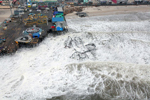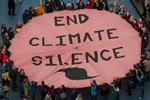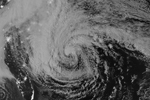
Hurricane Sandy on October 25th in the Caribbean. Photo by: NASA.
Although Haiti avoided a direct hit by Hurricane Sandy, the tropical storm caused severe flooding across the southern part of the country decimating agricultural fields. The UN Office for the Coordination of Humanitarian Affairs now warns that 1.5 million Haitians are at risk of severe food insecurity, while 450,000 people face severe acute malnutrition, which can kill.
“We have lost everything. If I do not find seeds and seedlings now, I will have to prepare them myself from remaining devastated crops. But it will take a year for them to be ready and more than six months after to harvest,” Nessilo Dorestant, a farmer in the southwest told the NGO ActionAid. “There is no possible way for my family to survive this long without food. All the farmers are in the same situation.” The government has said that 70 percent of agriculture in the southern part of the country has been wrecked.
ActionAid is calling on international donors to step-up assistance to the disaster-struck country in order to avoid a hunger crisis.
Haiti’s agricultural sector was already hard hit by Hurricane Gustav in August even before Sandy struck. Haiti declared a state of emergency on October 30th following Hurricane Sandy. In addition to inundating fields, the hurricane destroyed 6,274 homes and killed 54.
The hurricanes this year follow mass devastation wrought by an earthquake in 2010, which killed upwards of 200,000 people and over a million homeless. Considered the poorest country in the Western Hemisphere even before the earthquake, Haiti has yet to recover from the narural disaster.
Scientists warn that climate change may be increasing the severity of hurricanes. Warmer ocean waters means great precipitation, while rising sea levels add to storm surges.
Related articles
It’s not just Sandy: U.S. hit by record droughts, fires, and heatwaves in 2012

(11/05/2012) As the devastation wrought by Hurricane Sandy—killing over 100 people and producing upwards of $50 billion in damage along the U.S. East Coast—has reignited a long-dormant conversation on climate change in the media, it’s important to note that this is not the only weird and wild weather the U.S. has seen this year. In fact, 2012 has been a year of record-breaking weather across the U.S.: the worst drought in decades, unprecedented heatwaves, and monster forest fires. While climatologists have long stated that it is not yet possible to blame a single extreme weather event on climate change, research is showing that rising temperatures are very likely increasing the chances of extreme weather events and worsening them when they occur.
Photos of flooded New York Aquarium released

(11/02/2012) The Wildlife Conservation Society (WCS) today released pictures showing damage caused earlier this week at the New York Aquarium by Hurricane Sandy. The photos show extensive flooding in parts of the aquarium, which is located on the Coney Island boardwalk and is run by WCS.
Hours before Hurricane Sandy hit, activists protested climate inaction in Times Square

(10/30/2012) On Sunday, as Hurricane Sandy roared towards the coast of the Eastern U.S., activists took to the streets in New York City to highlight the issue of climate change. Activists organized by 350.org unfurled a huge parachute in Times Square with the words, “End Climate Silence,” a message meant to call attention to the fact that there has been almost zero mention of climate change during the presidential campaign, including not a single reference to the issue in the four presidential debates.
How climate change may be worsening Hurricane Sandy

(10/29/2012) While scientists are still debating some fundamental questions regarding hurricanes and climate change (such as: will climate change cause more or less hurricanes?), there’s no debating that a monster hurricane is now imperiling the U.S. East Coast. A few connections between a warmer world and Hurricane Sandy can certainly be made, however: rising sea levels are likely to worsen storm surges; warmer waters bring more rain to increase flooding; and hotter temperatures may allow the hurricane to push both seasonal and geographic boundaries.
Did Haiti’s deforestation, hurricane trigger deadly earthquake?
(01/04/2011) Erosion caused by hurricanes and large-scale deforestation may have contributed to last year’s devastating earthquake that killed more than 200,000 people in Haiti, according to a geologist at the University of Miami.